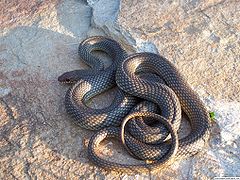- Caspian whipsnake
-
Caspian whipsnake 
Scientific classification Kingdom: Animalia Phylum: Chordata Class: Reptilia Order: Squamata Suborder: Serpentes Family: Colubridae Subfamily: Colubrinae Genus: Dolichophis Species: D. caspius Binomial name Dolichophis caspius
Nagy et al., 2004Subspecies - D. c. caspius
- D. c. eiselti
Synonyms The Caspian whipsnake (Dolichophis caspius, sometimes also Coluber caspius) also known as the large whipsnake (among various other species in genus Dolichophis / Coluber), is a common species of whipsnake found in the Balkans and parts of Eastern Europe.
Contents
Description
The Caspian whipsnake may grow to a maximum length of approximately 200 centimetres (79 in).[1] This species is not venomous and is mostly active during the day. The head is joined to the body by a thick neck. Its pupils are round. Nineteen rows of smooth scales can be found at the middle body, though rarely there may be seventeen. Dorsal scales each have two apical pores at the posterior edge. The centre of the scale is lighter in colour than the edges.[1] The dorsal side is grey-brown and features markings which are distinctive in juveniles and young snakes but fade with age. The ventral side is light yellow or white.
Taxonomy
Synonyms
Since its initial recording by Johann Friedrich Gmelin in 1789, D. caspius has been known by many names. A list of such synonyms is given below:[2]
- Coluber caspius (Gmelin in 1789)
- Coluber acontistes
- Coluber thermalis
- Coluber jugularis caspius
- Hierophis caspius
Distribution
The Caspian whipsnake is found in the Balkan peninsula, parts of Eastern Europe and a small portion of Asia Minor. It may be found in Albania, Bulgaria, Greece, Yugoslavia, Romania, southern Slovakia, European Turkey, Moldova, Montenegro, southern Ukraine, southern Russia, Kazakhstan, Jordan, and southern Hungary.[2][3] Results from a survey indicate that habitats may be distributed along low areas near major rivers, such as the Danube and the Olt river.[4]
It was previously assumed extinct in Moldavia (eastern Romania, southern Ukraine, and western Moldova), where it was only known from two sites, and not observed since 1937.[5] Three specimens were collected in May 2007 in Galaţi County, somewhat dispelling this belief.[5] Though it is known to be common in the Dobrudja area, knowledge of its distribution in other areas is poor. It is believed to be very rare in these parts, and may also be highly threatened. National legislation has stated that D. caspius is "a species of community interest" and thus must be strictly protected.[4]
In Hungary it was formerly thought only to exist in two areas: one near the capital of Budapest, and another near Szársomlyó. However, a recent survey of the region has yielded several previously-unknown whipsnake habitats along the river Danube, including sites near Dunaújváros and Dunaföldvár.[6] As in Romania, D. caspius is a protected species in Hungary.[6]
Habitat
Recently observed specimens of D. caspius were found in grassy, open areas with sparse shrubbery. They have also been found in open, bushy areas, specifically, between the Danube Meadow and Romanian Plain, near Căscioarele.[4] Vine covered areas were found near this habitat as well. At Drăgăneşti Olt, the species was found on a hilly slope.[4] Its habitat also includes rocky riverbanks and swampy areas, as well as gardens and cemeteries.
Diet
The Caspian whipsnake feeds on small vertebrates. Its diet may include small mammals, lizards, birds, and other snakes. Though not venomous, the Caspian whipsnake is considered "ferocious" and bites quickly and without warning. Due to its ability to consume rodents which may harm crops, it is valued as natural pest control.[1]
Conservation
There is relatively little data on the conservation status of D. caspius in many regions. Whilst it is known to be common in the Dobrudja area, it may be rare and threatened in other areas. In Drăgăneşti Olt, Romania, road-killed snakes are a "common sight" to locals. Traffic-related deaths may be a cause of their decline in Romania.[4] One of the recently observed habitats, the Romanian Plain, is known to be heavily affected by agriculture. Habitat loss to agriculture may also be a cause of the species' decline in Romania.[4] In Bulgaria, D. caspius is one of 31 most common species that represent 59% of the Bulgarian herpetofauna.[7]
References
- ^ a b c "Dolichophis caspius (Caspian Whip Snake)". TrekNature. http://www.treknature.com/gallery/Middle_East/Turkey/photo153326.htm. Retrieved 18 January 2010.
- ^ a b "Dolichophis caspius GMELIN, 1789". The Reptiles Database. J. Craig Venter Institute. http://reptile-database.reptarium.cz/species.php?genus=Dolichophis&species=caspius. Retrieved 18 January 2010.
- ^ Mazzei, Paolo; Ilaria Pimpinelli. "Dolichophis caspius (Gmelin, 1789)". Amphibians and Reptiles of Europe. http://www.herp.it/indexjs.htm?SpeciesPages/ColubCaspi.htm. Retrieved 18 January 2010.
- ^ a b c d e f Covaciu-Marcov, Severus-Daniel; Anamaria David (16 December 2008). "Dolichophis caspius (Serpentes: Colubridae) in Romania: New distribution records from the northern limit of its range". Turkish Journal of Zoology (TÜBİTAK). http://journals.tubitak.gov.tr/havuz/zoo-0812-4.pdf.
- ^ a b Strugariu, Alexandru; Iulian Gherghel (2007). "New record on the occurrence of Dolichophis caspius (Reptilia: Colubridae) in Romanian Moldavia". North-Western Journal of Zoology 3 (1): 5. http://herp-or.uv.ro/nwjz/content/v3.1/06.nwjz.3.1.Strugariu.pdf. Retrieved 18 January 2010.
- ^ a b Bellaagh, Matyas; Zoltan Korsos and Gdbor Szelenyi (2008). "New occurrences of the Caspian Whipsnake, Dolichophis caspius (Reptilia: Serpentes: Colubridae) along the River Danube in Hungary (Abstract)". Bulgarian Academy of Sciences, Sofia. http://cat.inist.fr/?aModele=afficheN&cpsidt=20661933. Retrieved 18 January 2010.
- ^ Tzankov, N.; B. Naumov, A. Grozdanov, D. Peshev, A. Vasilev (2009). "THE HERPETOFAUNA OF NORTHERN BLACK SEA COAST". BIOTECHNOL. & BIOTECHNOL. EQ. 23/2009/SE Special Online Edition. http://diagnosisp.com/dp/journals/view_pdf.php?journal_id=1&archive=0&issue_id=22&article_id=612. Retrieved 18 January 2010.
Categories:- Colubrids
Wikimedia Foundation. 2010.
